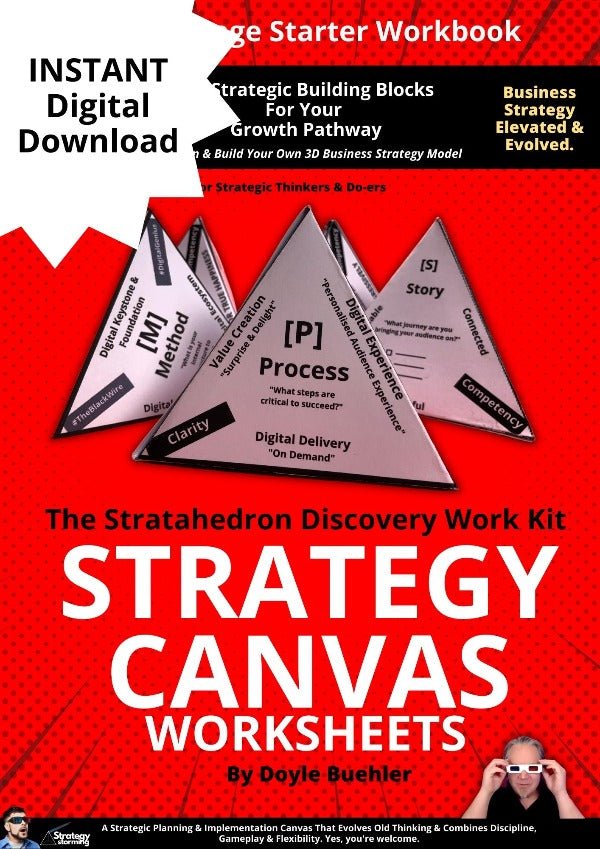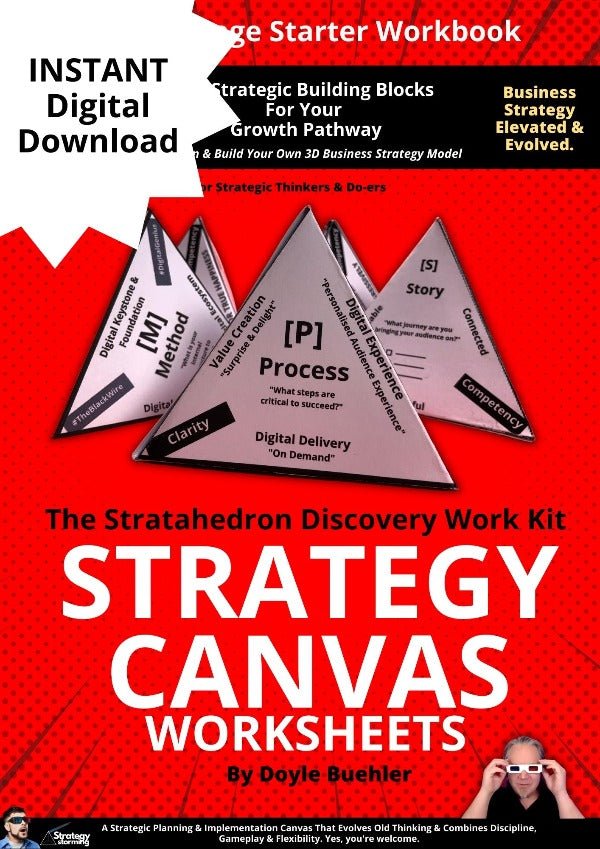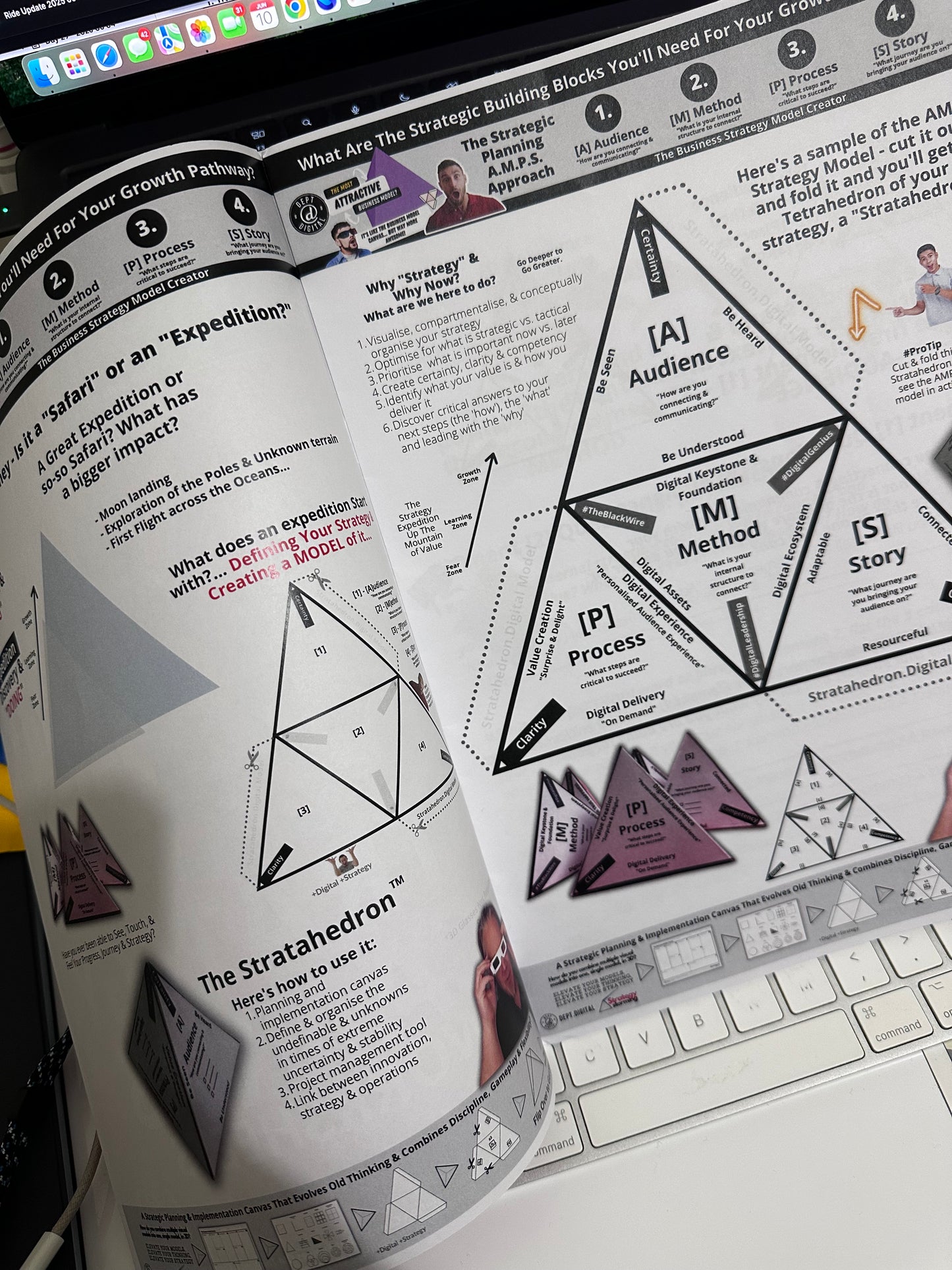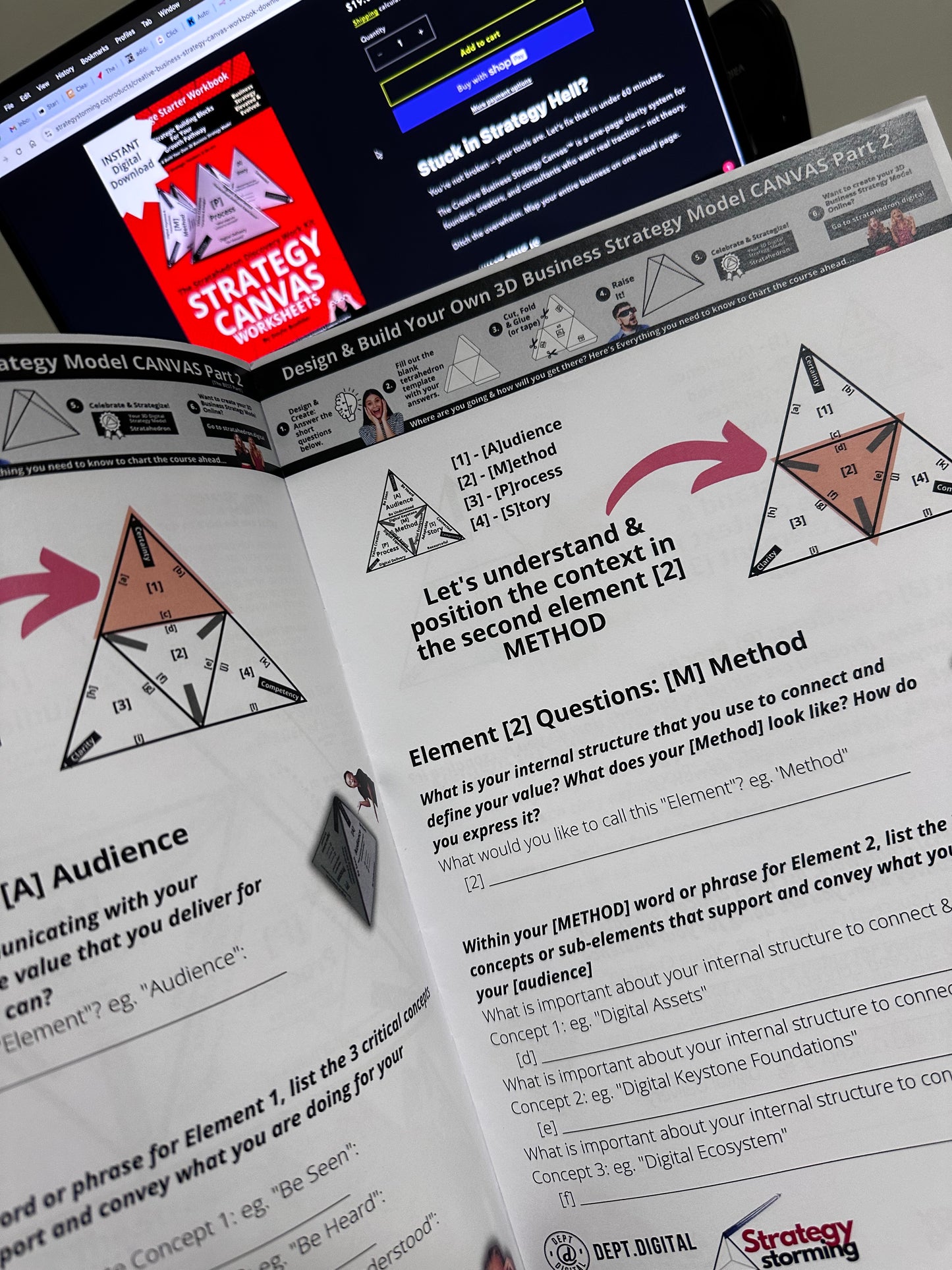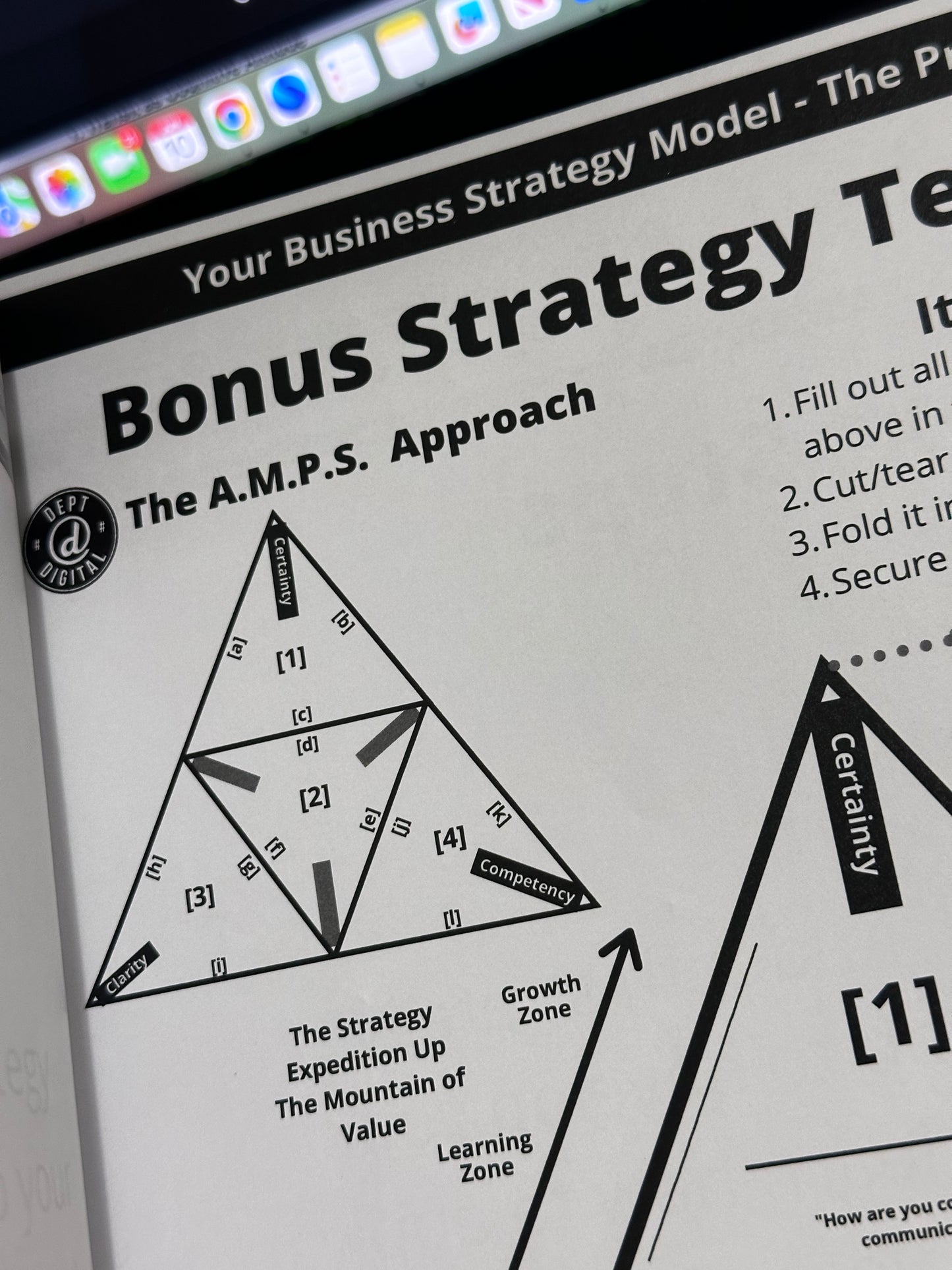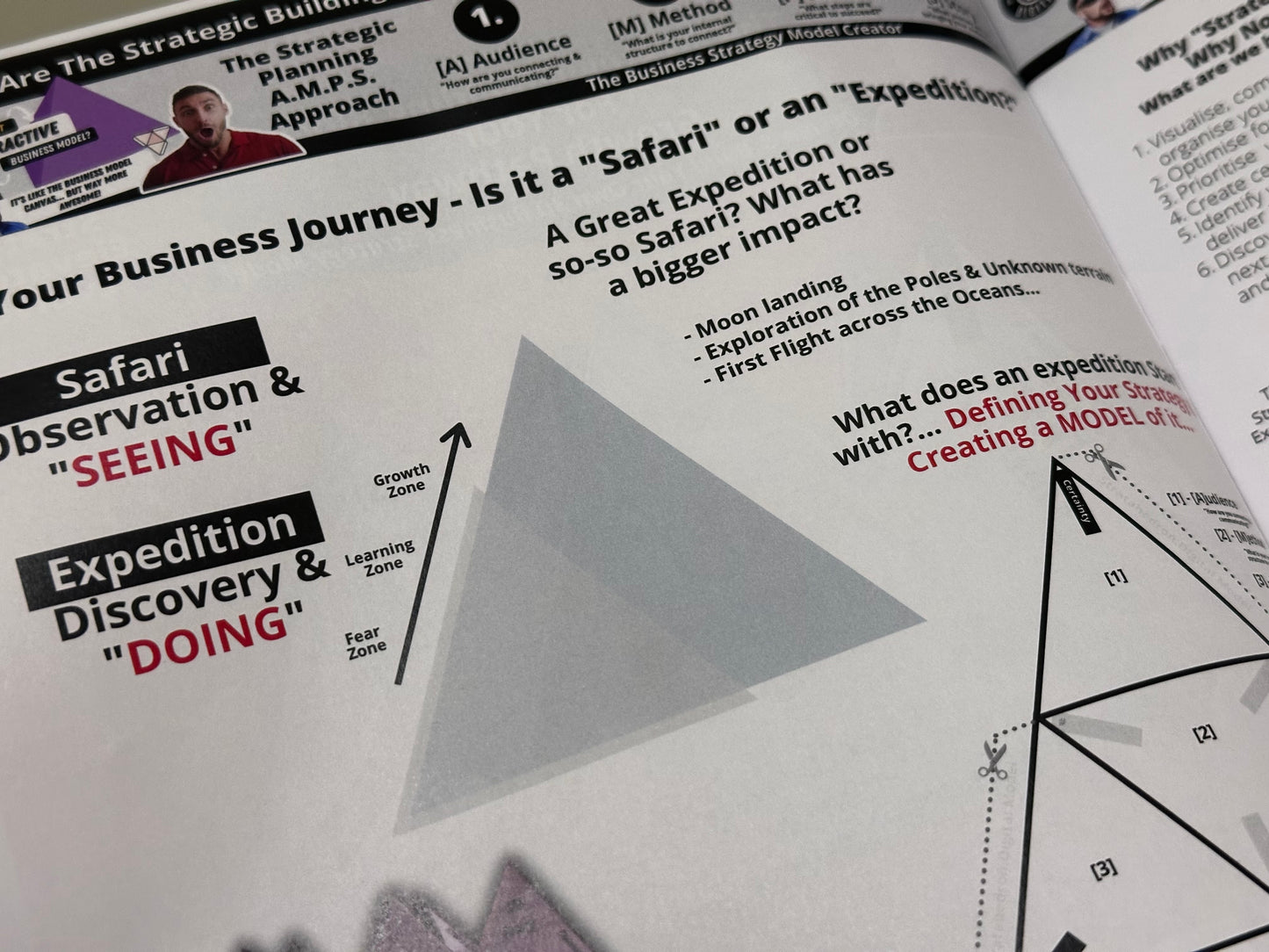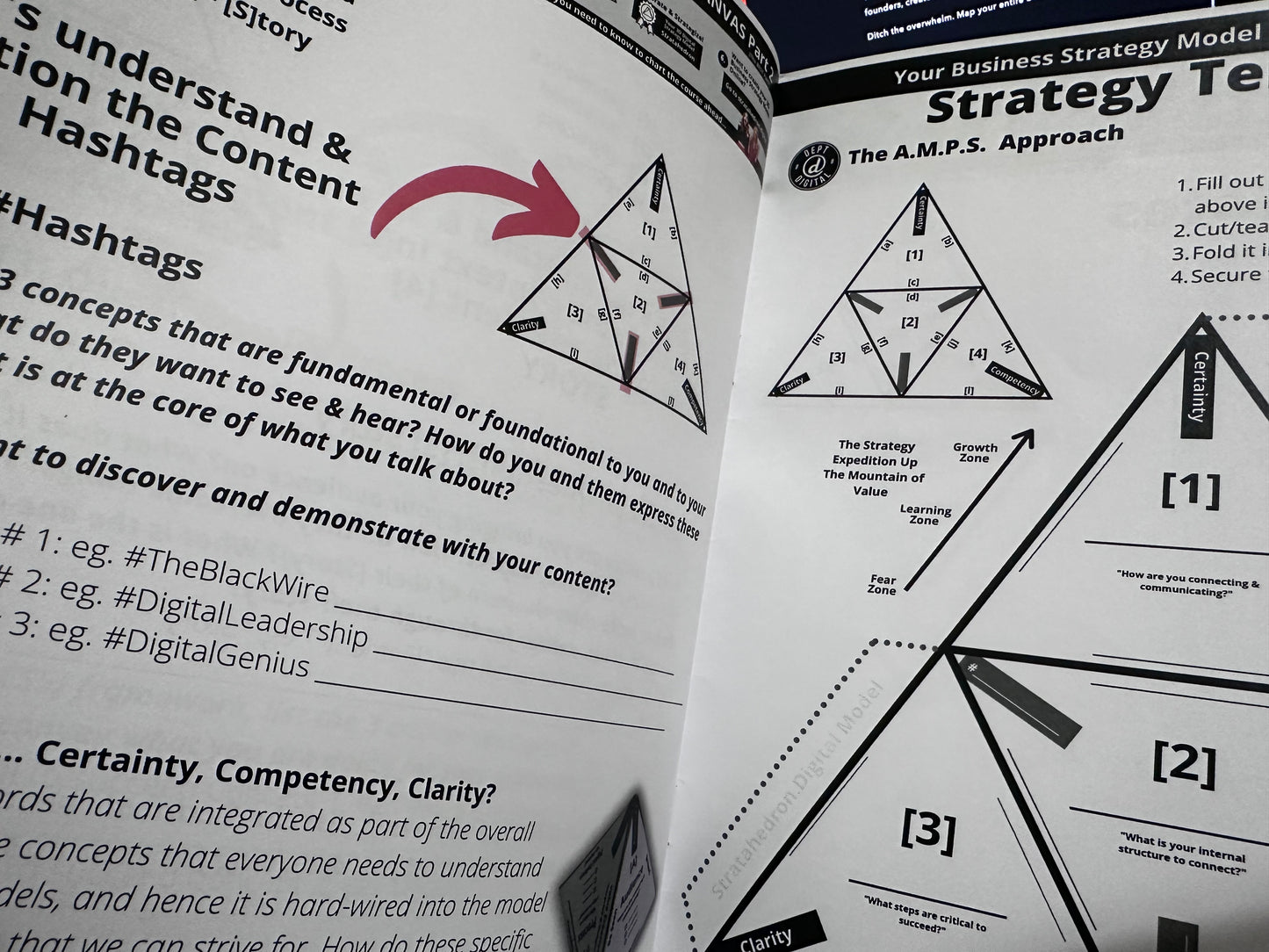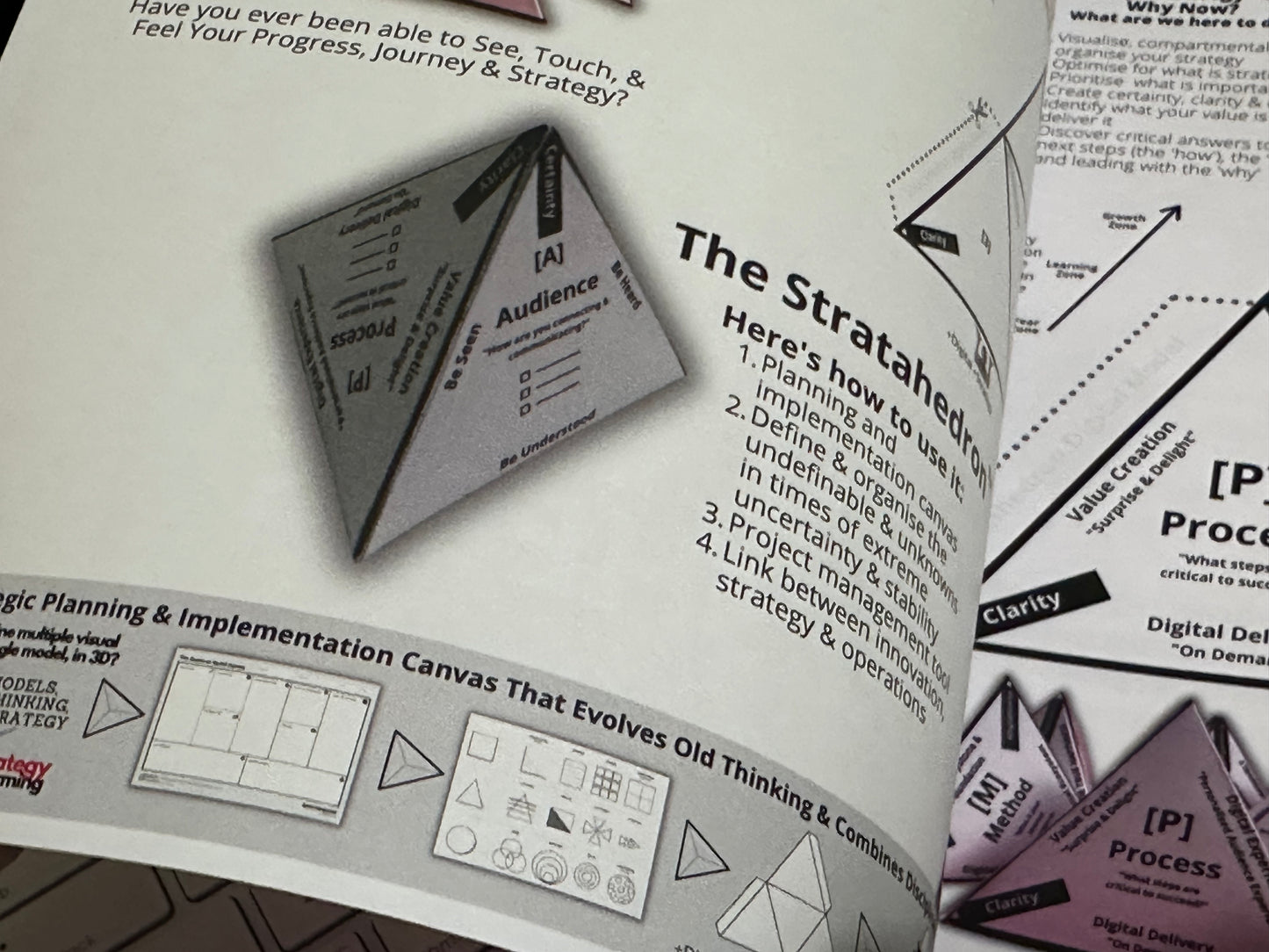
The Strategic Planning Success Blueprint: Navigating the Complex World of Planning With The Strategic Planning Checklist
Share
A Strategic Planning Success Blueprint: Navigating the Complex World of Planning With The Strategic Planning Checklist
Everything you need to know about Strategic Planning for Entrepreneurs and Small Business.
In the dynamic landscape of business, the ability to chart a clear course and navigate through challenges is paramount. Enter the "Strategic Planning Success Blueprint," a meticulously crafted checklist that serves as both a compass and a roadmap for those embarking on the journey of strategic planning.
Strategic planning, at its core, is the art and science of envisioning a desired future and translating that vision into broadly defined goals or objectives and a sequence of steps to achieve them. However, in today's fast-paced world, it's not just about setting a direction; it's about being agile, adaptable, and prepared for the unexpected twists and turns of the business world.
The "Strategic Planning Success Blueprint" is not just another checklist. It's a culmination of best practices, insights, and actionable steps that ensure every facet of strategy formulation and execution is considered. It's designed for those who are serious about making informed decisions, optimizing resources, and driving their organizations to success.
Who stands to benefit from this blueprint? The spectrum is broad. Whether you're a seasoned business leader, an emerging entrepreneur, a manager at the helm of a team, or even a professional looking to bring strategic thinking into your work, this checklist is your ally. It's tailored to guide individuals and teams responsible for shaping the direction of an organization or project, ensuring that no stone is left unturned.
Why is such a blueprint crucial? In the absence of a clear strategy, businesses risk wandering aimlessly, akin to ships lost at sea. Resources get misallocated, teams become directionless, and the organization's vision blurs. The "Strategic Success Blueprint" brings clarity, focus, and purpose. It aids in breaking the monotonous and often ineffective cycle of planning that many fall into, ensuring that strategic planning becomes a proactive, forward-thinking process rather than a reactive one.
By delving into this checklist, organizations can expect a myriad of benefits. Clarity in direction ensures that every team member knows where they're headed. Resources, both time and money, are utilized where they matter most. Risks are spotted from afar and mitigated, ensuring smoother sailing. More importantly, it fosters an environment where teams are aligned, collaborative, and driven by a shared purpose.
However, merely having the "Strategic Success Blueprint" isn't enough. It's essential to engage with it actively. Review each section, involve key stakeholders, and ensure that the checklist evolves as the business landscape changes. For those looking to elevate their strategic planning game, consider seeking expert consultation or training. The world of strategy is vast, and continuous learning is the key to mastery.
The "Strategic Planning Success Blueprint" is more than a tool or a strategic planning checklist; it's a commitment to excellence. It's a pledge to not just set goals but to achieve them. In the grand tapestry of business, it ensures that your strategic planning thread is not just another line but a vibrant, standout streak that guides the organization to success.
This sets the stage to delve into the "Strategic Planning Success Blueprint" with a clear understanding of its significance and the transformative impact it can have on your strategic planning endeavors.
How Can Strategic Planning Fail?
The "zig-zag" dilemma in strategic planning is a pervasive challenge, leading businesses into cycles of reactive decision-making rather than proactive strategizing.
This erratic zig-zag approach outlined here, often results in missed opportunities and misallocated resources. However, the solution lies in adopting structured tools like the Strategic Planning Checklist. This comprehensive guide serves as an antidote to the zig-zag conundrum, offering businesses a clear roadmap to navigate the complexities of strategy formulation.
By systematically following the checklist, organizations can break free from the sporadic annual zig-zag pattern, ensuring that their strategic efforts are consistent, well-informed, and aligned with their long-term vision and goals.
Strategic Success Blueprint: Navigating the Complex World of Planning with Simple Guiding Lights
In the dynamic landscape of business, the ability to chart a clear course and navigate through challenges is paramount. Enter the "Strategic Success Blueprint," a meticulously crafted checklist that serves as both a compass and a roadmap for those embarking on the journey of strategic planning.
But before diving deep, let's remember some simple guiding principles:
- The 3 Cs: Always keep in mind - Clarity in vision, Consistency in action, and Collaboration with your team.
- Simplicity Over Complexity: The best strategies are often the simplest. Don't overcomplicate.
- Listen, Learn, Lead: Listen to feedback, learn from experiences, and lead with confidence.
- Adapt and Achieve: In the face of challenges, adaptability is key. Stay flexible and focused on your goals.
Strategic planning, at its heart, is the art and science of envisioning a desired future and translating that vision into broadly defined goals or objectives and a sequence of steps to achieve them. However, in today's fast-paced world, it's not just about setting a direction; it's about being agile, adaptable, and prepared for the unexpected twists and turns of the business world.
The "Strategic Planning Success Blueprint" is not just another checklist. It's a culmination of best practices, insights, and actionable steps that ensure every facet of strategy formulation and execution is considered. It's designed for those who are serious about making informed decisions, optimizing resources, and driving their organizations to success.
Why is such a blueprint crucial? In the absence of a clear strategy, businesses risk wandering aimlessly, akin to ships lost at sea. Resources get misallocated, teams become directionless, and the organization's vision blurs. The "Strategic Success Blueprint" brings clarity, focus, and purpose. It aids in breaking the monotonous and often ineffective cycle of planning that many fall into, ensuring that strategic planning becomes a proactive, forward-thinking process rather than a reactive one.
By delving into this checklist, organizations can expect a myriad of benefits. Clarity in direction ensures that every team member knows where they're headed. Resources, both time and money, are utilized where they matter most. Risks are spotted from afar and mitigated, ensuring smoother sailing. More importantly, it fosters an environment where teams are aligned, collaborative, and driven by a shared purpose.
However, merely having the "Strategic Success Blueprint" isn't enough. It's essential to engage with it actively. Review each section, involve key stakeholders, and ensure that the checklist evolves as the business landscape changes. For those looking to elevate their strategic planning game, consider seeking expert consultation or training. The world of strategy is vast, and continuous learning is the key to mastery.
The "Strategic Planning Success Blueprint" is more than a tool; it's a commitment to excellence. It's a pledge to not just set goals but to achieve them. In the grand tapestry of business, it ensures that your strategic planning thread is not just another line but a vibrant, standout streak that guides the organization to success. And as you embark on this journey, remember the simple guiding principles; they'll serve as your North Star in the vast sea of strategic planning.
These simple guiding principles, woven into the narrative, will help you anchor you strategic planning efforts in easy-to-remember concepts, ensuring a more effective and streamlined approach to strategic planning.
Strategic Planning Success Blueprint: Your Ready-for-Planning Checklist
Summary: The "Strategic Success Blueprint" is a comprehensive checklist designed to guide businesses and individuals through the intricate process of strategic planning. It serves as a roadmap, ensuring that every essential aspect of strategy formulation and execution is considered.
Who Should Use It: This checklist is tailored for business leaders, managers, entrepreneurs, and any individual or team responsible for shaping the direction of an organization or project.
Importance: Strategic planning is the backbone of any successful venture. Without a clear, well-thought-out strategy, businesses risk moving aimlessly, wasting resources, and missing out on valuable opportunities.
What It Helps Achieve: The "Strategic Success Blueprint" aids in:
- Understanding the fundamentals of strategic planning.
- Prioritizing key actions and initiatives.
- Breaking the repetitive and ineffective "zig-zag" cycle of planning.
- Identifying genuine opportunities for growth.
- Cultivating a proactive and visionary mindset.
- Ensuring actionable and measurable strategy implementation.
Benefits: By following this checklist:
- Organizations can achieve clarity in direction.
- Resources are utilized optimally.
- Risks are identified and mitigated early.
- Teams become more aligned and collaborative.
- The chances of achieving long-term goals increase significantly.
Action to Take: To harness the full potential of this blueprint:
- Review each section thoroughly.
- Engage key stakeholders in discussions.
- Regularly revisit and update the checklist as the business environment evolves.
- Consider seeking expert consultation or training to further enhance strategic capabilities.
Consequences of Not Using It: Without a structured approach to strategic planning:
- Businesses may drift without clear direction.
- Resources could be wasted on non-impactful initiatives.
- Opportunities for growth might be overlooked.
- The organization could become reactive rather than proactive, leading to missed advantages.
- There's a higher risk of business stagnation or decline.
The "Strategic Planning Success Blueprint" is more than just a checklist; it's a guide to ensuring that your strategic planning is comprehensive, effective, and aligned with your organization's vision and goals.
Here's everything you need to know about Strategic Planning with the Strategic Planning Checklist

The Strategic Planning Checklist
1. Understanding Strategic Planning
- Research the Basics: Dive into the foundational concepts of strategic planning.
- Know Your Terms: Familiarize yourself with key terms like SWOT, PESTEL, and ROI.
- Historical Review: Examine past strategies to understand what worked and what didn't.
- Industry Trends: Stay updated with the latest trends in strategic planning and management.
- Case Studies: Study successful strategic planning implementations in similar industries.
- Consult Experts: Engage with strategic planning professionals or consultants.
- Attend Workshops: Participate in strategic planning workshops or webinars.
- Read Books: Delve into classic and contemporary strategic planning literature.
- Join Forums: Engage in discussions on strategic planning forums or online communities.
- Feedback Collection: Gather feedback on past strategies from team members and stakeholders.
2. Prioritization in Planning
-
Goal Setting: Clearly define short-term and long-term objectives.
-
Resource Allocation: Determine where to invest time, money, and manpower.
-
Urgency vs. Importance: Differentiate between tasks that are urgent and those that are important.
-
Stakeholder Analysis: Identify and prioritize key stakeholders.
-
Risk Assessment: Evaluate potential risks and develop mitigation strategies.
-
Time Management: Allocate sufficient time for each strategic initiative.
-
Budgeting: Set clear budgets for each strategic action.
-
Feedback Prioritization: Prioritize actions based on feedback received.
-
Technology Utilization: Prioritize the integration of tech tools in your strategy.
-
Team Involvement: Ensure team members are involved in the prioritization process.
3. Breaking the Zig-Zag Cycle
-
Consistent Monitoring: Regularly review and adjust strategies as needed.
-
Avoid Reactive Planning: Focus on proactive strategies rather than reactive ones.
-
Flexible Frameworks: Adopt strategic frameworks that allow adaptability.
-
Feedback Loops: Establish mechanisms to gather feedback and make necessary adjustments.
-
Celebrate Small Wins: Recognize and celebrate milestones to maintain momentum.
-
Stay Updated: Keep abreast of changes in the industry and market.
-
Avoid Complacency: Challenge the status quo and encourage innovative thinking.
-
Regular Training: Ensure the team is equipped with the latest strategic knowledge.
-
Stakeholder Engagement: Engage stakeholders regularly to ensure alignment.
-
Review Mechanisms: Set up periodic strategy review meetings.
4. Identifying Opportunities
-
Market Analysis: Understand market dynamics, opportunities, and threats.
-
Competitor Benchmarking: Analyze competitors to identify gaps and opportunities.
-
Innovation Scouting: Stay updated with technological advancements and innovations.
-
Customer Feedback: Listen to your customers to identify areas of improvement and potential opportunities.
-
Internal Audit: Regularly evaluate internal processes to identify efficiency gaps and areas of growth.
-
Trend Analysis: Monitor and analyze emerging trends in your industry.
-
Network: Engage with industry peers and experts to uncover hidden opportunities.
-
Surveys: Conduct surveys to gather insights and identify potential areas of expansion.
-
Pilot Projects: Test new ideas on a small scale to gauge their potential.
-
Collaborate: Partner with other businesses or experts to explore new opportunities.
5. Cultivating the Right Mindset
-
Continuous Learning: Stay updated with the latest in strategic thinking and methodologies.
-
Openness to Change: Embrace change as an opportunity, not a threat.
-
Collaborative Thinking: Foster a culture of collaboration and collective problem-solving.
-
Risk Tolerance: Cultivate a mindset that views risks as opportunities for growth.
-
Visionary Thinking: Always keep the bigger picture in mind, focusing on long-term goals.
-
Embrace Failure: Understand that failures are stepping stones to success.
-
Stay Curious: Encourage a culture of curiosity and continuous questioning.
-
Feedback Appreciation: Value feedback as a tool for growth and improvement.
-
Diversity of Thought: Encourage diverse thinking and perspectives.
-
Stay Positive: Maintain a positive outlook, even in challenging times.
6. Actionable Strategy Implementation
-
Clear Communication: Ensure that every team member understands the strategy and their role in it.
-
Regular Training: Equip your team with the skills and knowledge they need to execute the strategy.
-
Feedback Mechanisms: Establish regular check-ins and feedback sessions.
-
KPI Tracking: Set and monitor Key Performance Indicators to measure success.
-
Iterative Approach: Be prepared to iterate and refine the strategy based on results and feedback.
-
Resource Management: Ensure optimal utilization of available resources.
-
Collaboration Tools: Use tools that foster collaboration and seamless communication.
-
Stakeholder Engagement: Regularly update and engage with stakeholders.
-
Celebrate Success: Recognize and reward successful strategy implementation.
-
Review and Adjust: Continuously review the strategy and make necessary adjustments.
This expanded checklist provides a detailed roadmap for businesses to navigate the complexities of strategic planning, ensuring a holistic and effective approach.
Additional Strategic Planning Resources
Download your Free SWOT Strategic Designer PDF (Strengths, Weaknesses, Opportunities, Threats)
Find out now how Can You Use SWOT For Your Business.
Grab your free SWOT 1-Page Designer PDF for Free.
Related Posts
-

How to Use Strategy to Improve Revenue: A Comprehensive Guide
Finding ways to improve revenue is essential & possible with Strategy
-
![The Entrepreneur Journey is Broken? [Part 1] - Strategystorming - The Strategy Studio & Shop for Strategic Thinkers](//strategystorming.co/cdn/shop/articles/the-entrepreneur-journey-is-broken-part-1-590109.webp?v=1701206679&width=170)
The Entrepreneur Journey is Broken? [Part 1]
What if the Entrepreneur Journey could be different?
-

Creating Certainty in an Uncertain Business Environment with The Business Design Strategy Sprint
-

How do you build a Strategy Operating System?
-

Business Strategy Mastery Workshop - Strategy Masterclass October 2022 Intake - Session Now Closed
Business Strategy Mastery Workshop - Strategy Masterclass October 2022 Intake Now Closed. It's time to rethink & reinvent how we think about strategy, but also how we understand, design, and create it. Get the thinking, tools, and know-how to craft business strategy like never before.
-

8 Simple Questions Every Strategy Must Answer to Be Able to See Your Greatest Competitive Advantage
Your biggest competitive advantage that you can ever have is how you think and how you problem solve better than anyone else, especially in these challenging times.
This is your strategic thinking, only you have it, and your future really does depend on it.
-

Is Business An Art Or More About Science? Hint: It's Neither
👉Being more clever
👉Being more creative
👉Being more skillful
👉Thinking more strategically
👉Reducing complex ideas & problems
👉Crafting uncommon solutions
👉Embracing complexity
-
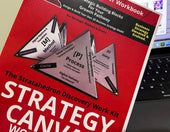
Is Your Strategy Still Just a Pile of Notes and Guesswork?
The Creative Business Strategy Canvas™ is the clarity tool I built after hitting that wall one too many times.It’s one page. Visual. Brutal. Honest.
It shows you your business — as it actually is — so you can build what it’s meant to be.
-

Reinventing Rapid Business Growth With The Strategy SuperModels
Enter The World of Business Strategy SuperModels - Redefine and Reinvent
-

Unlock Business Growth with The Growth Pathway Strategy GPS SuperModel
Unlock Business Growth with The Growth Pathway Strategy GPS SuperModel
-

4 Strategic Steps to Rethink and Reimagine SWOT Analysis for Your Business
Here's How to Reimagine & Customize your SWOT with a Custom SWOT Analysis Worksheet
-

Reimagining & Reinventing Ikigai for Brand Strategy Design Consultants & Strategists
Exploring Brand Strategy Models & Case Studies In Strategy - The Reimagining of the Ikigai Model - The Strategy Super Model Series
-

Exploring Brand Strategy SuperModels & Case Studies in Strategy
-

FlightPath Day 80 of 100: Rhythm Over Hustle - How Founders don’t burn out from work
-

Want to Obtain Better Business Results in 4 Easy Steps? Keep it Simple - Here's A Really Simple Strategy With BIG Impact
-

10 Must-Haves to Master Your Digital Landscape - The Strategy Playbook
Transform Your Business Online With Clearcut Success Strategies In This Strategy Playbook
-

Do You Want to Lose Track of Your ‘Why’ & ‘How’ amongst all of the ‘WTFs’?
You’ll build out your business journey as your “FlightPath” with a close-knit group using the wisdom of your peers for reimagining your perspective, driving your OWN priorities & finding your OWN critical solutions.
-

How to Use Strategy to Improve Brand Awareness - The Brand Strategy Guide
Here's How to Use Strategy to Improve Your Brand Awareness
-

How to Use Strategy to Improve Market Share: What's Really Important?
How Do You Improve Market Share With Strategy?
-

How to Use Strategy to Improve Innovation - Your Innovation Playbook
Understanding the Connection Between Strategy and Innovation
-

How to Use Strategy to Improve Growth - A Definitive Guide
Strategy is an ongoing, dynamic process of Growth
-

10 Rules of a Strategy-Focussed Entrepreneur That Really Matter
What's really important for a strategy-focussed entrepreneur?
-

10 Rules That Really Matter for a Digital-Focussed Enterprise
Here's 10 simple rules to see if you are a digital-focussed business.
-

10 Invaluable Strategic Business Insights for Today’s Highly Competitive Business Environment.
10 invaluable insights for today’s highly competitive business environment using The Art of War
-

The Annual Strategic Planning Panic Season Has Begun! Ditch the Drama, Embrace the Plan: Less Zigging, More Winning!
Strategic Planning Panic Season. Ditch the Drama, Embrace the Plan: Less Zigging, More Winning!
-

Unlock Your Business Brand Secrets: Master Your Brand & Strategy with the Strategystorming Sprint.
Don't let market disruptions steer you off course; take the helm of your business with unwavering confidence by mastering the art of strategic planning. This is your roadmap to not just surviving but thriving in today's volatile business landscape.
-

Can AI make you MORE Creative, Curious, Innovative AND more strategic? Yes or no?
Can AI make you MORE Creative, Curious, Innovative AND more strategic? Yes or no?
What if it could?
-

What You Think You Already May Know About Cognitive Biases...May Be Wrong
-

A Good Strategic Thinker And A BETTER Strategic Thinker - What's The Difference?
Improve your strategic thinking skills and increase your growth potential.
-

Good Strategy vs Bad Strategy. 5 Simple Symptoms To Identify a Really Bad Strategy.
What are the symptoms and signals that can help diagnose a potentially Good Strategy vs an ineffective Bad strategy?
-

Why Your Strategy Must Not Become A To Do List - The Only 5 Strategic Questions You Cannot Exist Without
By taking the time to answer these questions, you can develop a clear understanding of your company's purpose, its big idea, and how you're going to deliver value to your customers. This will help you to stay focused and on track as you build your business.
-

IMPACT: What would you actually do if you had more of it for your business?
Here's how to find and start to build your impact that lasts with digital strategy
-

The Business Top Gun's Playbook: Harnessing Speed of Strategy and Strategic Direction for Navigation for Impact
-

Which 4 Critical Components You Might Be Missing With Your Strategy - Here's How to Make Your Strategy Quicker, Cheaper & Easier
Is Your Strategy Too Hard? Here's How to Make Your Strategy easier to create, implement & execute without breaking a sweat
-

Strategystorming For Your Future: How Can Reinventing Strategy Help Future-Proof Your Business?
The Future May Be Uncertain, But You Don't Need To Be.
Strategystorming is a powerful tool for achieving success and creating a brighter future. By taking control of your destiny and developing effective strategies, you can overcome any obstacle and achieve your goals, no matter how big or small. -

The Power Of The Prompt - The Strategic Look At Artificial Intelligence Alignment & Business
-

Do You Have A Brand Plan? Here's how to Rethink & Stack the odds and start winning with a brand strategy
-

The 5 Key Strategic Factors You Need To Consider to Integrating AI into your Business Now. Here's How To Get Started to Integrate AI Effectively Into Your Business
5 Key Strategic Factors You Need To Consider In Integrating AI into your Business
What would happen if 80% of what you do is commoditized into the same thing that everyone else is doing? If you can no longer compete on price, and everything is now a commodity, what would you do? How can you accelerate your business while everything is accelerating around you?
-

What's Good Strategy or Bad Strategy? Fighting Fires Is No Longer a Startup Badge of Honour. We need to Reinvent How We Think About Strategy For Startups.
What's Good Strategy or Bad Strategy? Fighting Fires Is No Longer a Startup Badge of Honour. We need to Reinvent How We Think About Strategy For Startups and Smart Strategy for Business.
-

Sometimes we can be extremely surprised at how 'strategic' some things are when we compare it to other things. Here's a case in point.
Here's a case in point about how to get epic things done...strategically - without trying that hard.
-

Anyone can start a business, but can you finish one? Can you get yours to the finish line without a strategy?
Anyone can start a business, but it takes a special skill to finish one - strategy builds a business built to last. Are you building your business to last? It’s not a map, not a business model, not a SWOT, not a business plan, not a 1-page Marketing Plan; it's your strategy operating system that defines the difference.
-

Strategy is about change, and we are all architects of change with our strategic thinking
You're In The Business of Change. You Just Don't Know It...Yet.
What does it take to see Change?
How do we adapt change and think more strategically in the solutions that we deliver, and want to deliver?
-
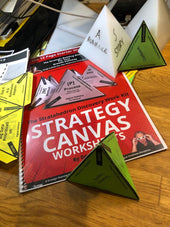
Why being agile doesn’t save a small business? It’s more about your strategic thinking.
The solution to being agile is more about strategy and your strategic thinking ability
-

The Strategystorming Strategy Studio & Shop Launch Event Speakers Summary
It's strategic clarity & #certainty to help you know how to craft a better strategy, and use strategic & tactical tools for profitable growth and a superior ROI by leveraging the power of your brand.
-

The True Power of Reinvention for Business & Rethinking How We Create Remarkable, Winning Strategies - The Strategystorming Strategy Studio & Shop Launch
-

The Truth About What You Should Be Focussing More On in Your Business - Hint: It's 99% invisible
We don't investigate fully how our customers and audience are thinking - we simply gloss over what we think they need. We rarely feel that we 'need' a strategy to enhance what we're doing to drive profitability and how to win - or that it's something that only big companies have to do to please their corporate rulers. And, seldom do we use any systems to create better efficiencies.
-

How Easy Is It To Sacrifice Tomorrow for Today, Without Even Knowing It? Are You A Slave To The Now Because of Your Strategy in Business?
How Easy Is It To Sacrifice Tomorrow for Today, Without Even Knowing It? Are You A Slave To The Now Because of Your Strategy in Business?
-
![#SmartStrategy [Designing Your Strategy For Business] - Strategystorming - The Strategy Studio & Shop for Strategic Thinkers](//strategystorming.co/cdn/shop/articles/smartstrategy-designing-your-strategy-for-business-256943.jpg?v=1693515536&width=170)
#SmartStrategy [Designing Your Strategy For Business]
Strategy is often what you need to do, but also what you don't need to do. It tells you what you see, but also what you don’t see.
-

Is Bigger All There Is in Business? What does the word GROWTH actually mean for GROWING a business?
If only we could grow more, if only we could scale more, if only we could...
-

Is 'Bigger' All There Is? Reinventing & Rethinking Your Business With Strategy
Strategystorming is the new thinking place where we become better strategic thinkers, by applying strategy here and now, sharing what strategy is for business, and how best to realise it and craft it into remarkable experiences.
-

Do You Know The Biggest Reasons Why a Business Fails? It's Not Because of Tech & Creativity
Why does a business fail, and what can you do about it?
Planning & #strategy is not a "to-do list"
It's not even a list of goals you want to achieve, or "what do you want to become in 2022?" (are you a flower? 😂)
-

What will it take for things to return to business as usual?
It's not business as usual anymore. The Easy Strategy Lab is where we find out how to Reinvent & Reimagine & Rethink business.
We are back with a Strategystorming Show on the 4 greatest myths about strategy, change & reinvention - the misconceptions and outdated assumptions that might be killing your efforts or the efforts of your clients today.
-

Strategy Expeditions for Reinvention, Growth & Performance by Strategystorming - The Strategy Mastery Training Course Workshop
What's Creative Intelligence & Strategic Innovation?Learning strategy and implementation with creative tools and storytelling.Unleash the potential within your business or clients to solve your unique business challenges and create dynamic resilient futures.Meet our Creative Intelligence and Strategic Innovation course - Strategy Mastery Training.
It's education, but not as you know it.
It's a workshop Expedition - a Strategy Expedition to get you to your destination... and back, learning, creating, understanding and crafting your ultimate strategy of resilience & success.

![The Entrepreneur Journey is Broken? [Part 1] - Strategystorming - The Strategy Studio & Shop for Strategic Thinkers](http://strategystorming.co/cdn/shop/articles/the-entrepreneur-journey-is-broken-part-1-590109.webp?v=1701206679&width=170)













































![#SmartStrategy [Designing Your Strategy For Business] - Strategystorming - The Strategy Studio & Shop for Strategic Thinkers](http://strategystorming.co/cdn/shop/articles/smartstrategy-designing-your-strategy-for-business-256943.jpg?v=1693515536&width=170)




